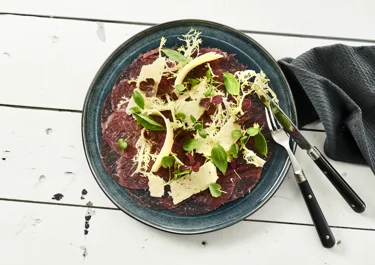
Carpaccio

Instructions
FAQ: Questions about carpaccio
If you want to know more about carpaccio, you have come to the right place. Below, we have answered some of the most commonly asked questions about this dish.
Ingredients
Beef fillet in very thin slices | 100 g |
|---|---|
Olive oil | 1½ tbsp |
Freshly squeezed lemon juice | 2 tsp |
| 25 g | |
Freshly ground pepper |
Garnish
Frisée salads, watercress and/or sorrel |
|---|
To serve
Toasted bread |
|---|
Tips: Make the best carpaccio
Below, we provide some of the best tips for making carpaccio. Have a look to learn more.
Choose high-quality beef
When selecting beef for carpaccio, it is important to focus on both the cut and the quality, given that the meat is served raw. The traditional choice for carpaccio is beef tenderloin, also known as filet mignon, as it is tender and has a low fat content. This cut is ideal for carpaccio due to its soft texture and subtle flavour, which pairs beautifully with the simple seasoning.
Look for cuts that are vibrant red in colour without any dull or greyish tones. Although tenderloin is lean, a bit of marbling can enhance the flavour, but be cautious not to select a cut that is too fatty, as the fat can overpower the dish.
If you plan to slice the meat yourself, consider buying a large enough piece to facilitate wide, thin slices.
Try pre-sliced beef
If you find it difficult to slice beef thinly at home, pre-sliced beef from Asian markets is an excellent alternative. These slices are often prepared for Korean barbecue and are cut to the ideal thinness for a delicious carpaccio. This saves time and ensures that each slice has the same thickness.
Enjoy our easy recipe for beef carpaccio
Our easy recipe for beef carpaccio celebrates the simplicity and elegance of Italian cuisine. With just a few ingredients, you can effortlessly create a stunning arrangement of delicately thin beef slices. This meat is prized for its rich umami taste and tender texture that almost melts in your mouth. This dish showcases how minimalism can be strikingly impressive, enticing friends and family to savour slice after slice of exquisite beef.
Stay on the Italian course and try our recipes for vitello tonnato with veal, crispy arancini balls made from risotto, as well as classic pasta alla Norma.
Drizzled with olive oil and lemon juice
Arrange the beef neatly on the plate and lightly drizzle olive oil and lemon juice over it to enhance the meat’s natural flavours. The olive oil adds a sumptuous depth to each bite, while the lemon juice introduces a bright, tangy contrast. Top it off with a light sprinkle of rich, subtly nutty Parmesan or aged cheddar for a heavenly flavour pairing.
Discover a classic Italian appetiser
The term “carpaccio” was inspired by Vittore Carpaccio, an Italian painter famed for his red and white colour palette, mirroring the raw beef’s red hues used in the dish. Created in the 1950s by Giuseppe Cipriani at Harry’s Bar in Venice, the dish was originally prepared for a countess who needed to eat raw meat for medical reasons. Over the years, carpaccio has become a beloved Italian starter, evolving into a component of tapas platters and incorporating various meats. So, if you want to add a bit of Italian tradition to your dinner party, what better way to do it than with carpaccio?
Experiment with the recipe
For a refreshing take on traditional carpaccio, try going for sushi-grade fish like tuna or salmon. These two types of fish bring a combined light and rich flavour and are typically accompanied by soy sauce for dipping and a few slices of jalapeño for added spice. There is also a growing popularity for vegetarian versions, where thinly sliced vegetables like artichoke or fennel mimic traditional beef carpaccio. These vegetables provide a subtle liquorice flavour and a satisfying crunch. Whether you choose these inventive variations or stick to the traditional carpaccio, you are guaranteed a luxurious appetiser that will surely impress friends and family.











